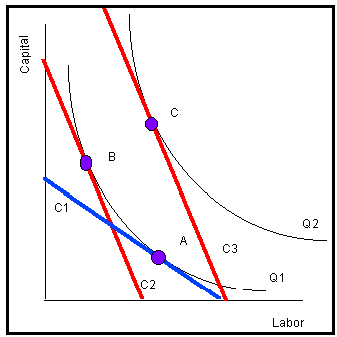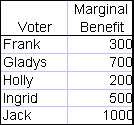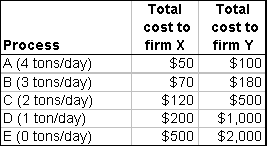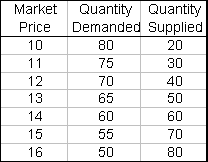
This practice final consists of 50 questions of the same coverage and difficulty as the actual final exam (which will have 50 questions). You will have 2 hours to do the actual final.
Glossary of abbreviations:
AFC = average fixed cost
ATC = average total cost
AVC = average variable cost
K = capital (quantity)
L = labor (quantity)
MB = marginal benefit
MSB = marginal social benefit
MC = marginal cost
MSC = marginal social cost
MP = marginal product
MR = marginal revenue
MRP = marginal revenue product
P = price
Q = quantity
R = rental price of capital
VMP = value marginal product
W = wage rate
1. Postal delivery is a service that has
A. rivalry in consumption and excludability.
B. rivalry in consumption and nonexcludability.
C. nonrivalry in consumption and excludability.
D. nonrivalry in consumption and nonexcludability.
2. The United States Old Age, Survivors, Disability and Health Insurance system (Social Security and Medicare)
A. is an example of a public good.
B. is an example of a tax and transfer system in which relatively rich persons' income is
transferred to relatively poor persons.
C. is an example of a tax and transfer system in which young persons' income is
transferred to older persons.
D. is neither a public good nor a tax and transfer system.
E. could be completely replaced by a private system that all young persons would prefer.
3. Which of the following statements is not true of mandated employment benefits in which the employer is required to provide a benefit, like health care, as part of the employee compensation?
A. A mandated benefit increases labor supply compared to what it would otherwise be.
B. A mandated benefit decreases labor demand compared to what it would otherwise be.
C. Wages tend to be depressed by mandated benefits.
D. Employees generally value mandated benefits more highly than if the money was used
toward wages by employers.
E. A federal government requirement of employers to give time off for the care of sick
relatives is an example of a mandated benefit.
4. The difference between the average annual return on a portfolio of common stocks and the average annual return on a U.S. Treasury Bond (assumed to be risk free)
A. compensates the investor for the fact that in any portfolio, on any given day, some
stock returns go up while others go down.
B. compensates the investor for the fact that in any portfolio, on any given day, all of
the component stock returns tend to go up or down together.
C. is not related to the underlying risks of common stocks.
D. reflects the fact that U.S. Treasury Bonds are poor investments.
E. reflects the fact that investment advisors are influential in the sale of common
stocks.

5. In the figure immediately above, which of the following statements is false?
A. The cost of every combination of labor and capital along the line C1 is the same.
B. The output from every combination of labor and capital along the line Q2 is the same.
C. The cheapest way to produce the output level on Q2 is the point C if labor and capital
prices are those for the line C1.
D. The movement from A to B is the substitution effect associated with decreasing the
price of capital relative to labor.
E. The movement from B to C is the expansion effect associated with lower marginal cost as
a result of the decrease in the price of capital between C1 and C2.
6. Marginal productivity theory indicates that those with more human capital
A. work more hours than their counterparts.
B. work fewer hours than their counterparts.
C. will earn higher wages than their counterparts.
D. are more highly motivated than their counterparts.
E. come from wealthier families than their counterparts.
7. If the wage rate of lawyers rises and that of business managers is fixed,
A. the supply of business managers will decrease and the quantity supplied of lawyers
will increase.
B. the supply of business managers will increase and the quantity supplied of lawyers will
increase.
C. the supply of both professionals will increase.
D. the supply of both professionals will decrease.
8. When the government uses a subsidy in the case of a positive externality, it sets the subsidy equal to
A. the marginal social benefit less marginal private benefit of the good providing the
externality.
B. the marginal private benefit less the marginal social benefit of the good providing the
externality.
C. the sum of the marginal social and private benefits of the good providing the
externality.
D. the product of the marginal social and private benefits of the good providing the
externality.
E. the marginal social benefit less the marginal social cost of the good providing the
externality.
9. Because of the substitution effect, labor supply
A. tends to be upward-sloping.
B. tends to be downward-sloping.
C. tends to be horizontal.
D. tends to be vertical.
E. has no definable shape.

10. In the figure immediately above, the substitution effect of a decrease in the relative price of capital from isocost line C1 to isocost line C2 is illustrated by the movement
A. from A to C.
B. from B to C.
C. from A to B.
D. from B to A.
11. Suppose that there are only two factors of production for some good: fuel and labor. When the price of labor increases, the derived demand for fuel
A. increases if the substitution effect dominates the expansion effect.
B. increases if the expansion effect dominates the substitution effect.
C. increases in all cases.
D. decreases in all cases.
12. You work as a policy maker and you have to vote for a tax increase on producers in one of the following markets. Which market will you choose if your main concern is to minimize the deadweight loss?
A. A market with elastic supply and elastic demand.
B. A market with inelastic supply but elastic demand.
C. A market with elastic supply but inelastic demand.
D. A market with inelastic supply and inelastic demand.
E. A market with many substitutes.

13. The figure immediately above shows a labor market in which the employer and employee each pay an equal percentage payroll tax on the employee's gross annual pay. The deadweight loss from this tax is the area inside the points labeled:
A. ACE
B. BDF
C. ABF
D. FDE
E. BCD
14. Fred and Alma are motor mechanics. It takes Alma 4 hours to replace a clutch and 12 hours to replace a set of brakes. It takes Fred 8 hours to replace a clutch and 16 hours to replace a set of brakes.
A. Alma has a comparative advantage in replacing clutches relative to Fred because she
can do it faster than Fred.
B. Alma has a comparative advantage in replacing brakes relative to Fred.
C. Fred has a comparative advantage in replacing clutches relative to Alma.
D. Fred has a comparative advantage in replacing brakes relative to Alma.
E. If Alma and Fred go into business together, they can't gain from specialization.
15. Suppose the risk-free promise to deliver $100 in one year had a present value of $95.24 (5% annual interest). Suppose further that the risky promise to deliver $200 in one year if GDP goes up (probability of 1/2) and nothing if GDP goes down (probability of 1/2) had a present value of $80 (25% annual interest). What is the risk premium on the risky promise?
A. 5%
B.10%
C. 15%
D. 20%
E. 25%
16. A risk that does not depend upon the condition of the economy is called a
A. market risk.
B. diversifiable risk.
C. systematic risk.
D. nondiversifiable risk.
E. real risk.

17. The five voters of Suntown are considering constructing a public pool that costs $2,000 to build and is big enough to accommodate all of them without congestion. Their marginal benefits from this pool are shown in the table immediately above. Which of the following are true?
A. A plan to build the pool, granting all citizens access and taxing all citizens $400
each, would pass a majority vote.
B. A private monopolist, restricted to charging a single price would conclude that the
best access fee is $500 but the project is not worth doing.
C. The voters of Suntown would also approve a plan to build the pool, tax each citizen
$300, and charge an access fee of $300.
D. A price discriminating monopolist would build the pool, charge a $400 access fee, and
just break-even.
E. A and B.
18. Gains to trade mean that both the buyer and the seller benefit from a voluntary exchange of goods or services.
A. True
B. False

19. The citizens of Coolville are considering constructing a public ice rink that costs $2,000 to build and is big enough to accommodate all of them without congestion. Their marginal benefits from this rink are shown in the table immediately above. Which of the following are true?
A. A plan to build the rink, granting all citizens access and taxing all citizens $400
each, would pass a majority vote.
B. A price discriminating monopolist would not build the rink.
C. Oskar is the median voter, and is opposed to the plan to build the rink and levy an
equal tax on all citizens.
D. A single price monopolist would build the rink and charge an access fee of $450.
E. A and B.
20. Governments operate tax and transfer systems because
A. market outcomes are not Pareto Efficient and tax and transfer systems correct this.
B. market outcomes can create an unequal distribution of incomes and tax and transfer
systems make this distribution more equal.
C. governments have better information about the value of money to rich and poor persons.
D. market outcomes, which are usually Pareto Efficient, are not affected by the more equal
income distribution that tax and transfer systems produce.
E. the distortions to market outcomes caused by the tax and transfer system are small
compared to the benefits of the more equal income distribution.
21. If a good's production process results in pollution, and the government taxes producers to pay for cleanup costs, then
A. the quantity of the good produced will increase.
B. the price of the good will decrease.
C. more resources will be devoted to the product.
D. supply will decrease.
E. consumers will purchase more of the good.

22. Referring to the table immediately above, suppose the citizens are subject to a 25% tax on gross income from zero to $45,000 and a 60% tax on gross income above $45,000. All citizens with gross income below $15,000 are eligible for a nontaxable $5,000 support payment from the government. Which of the following statements is false?
A. Sophie's marginal tax rate is 0.60 and the tax bill is $38,250.
B. Ramon's marginal tax rate is 0.25 and the tax bill is $7,500.
C. Quesare's marginal tax rate is 0.25 and the tax bill is $2,750.
D. Quesare's after tax-and-transfer income is $13,250.
E. Ramon's after tax-and-transfer income is $27,500.
23. Suppose the relative price of rice in terms of computers in Japan is 2 computers per unit of rice. The relative price of rice in Korea is 1/2 computer per unit of rice. If the two countries trade without government restrictions, transportation costs are negligible, and markets are competitive, then the likely terms of trade will fall in the range of
A. 4 to 5 computers per unit of rice.
B. 3 to 4 computers per unit of rice.
C. 2 to 3 computers per unit of rice
D. 1/2 to 2 computers per unit of rice.
E. 1/4 to 1/2 computer per unit of rice.
24. When a positive externality exists in the production of a good,
A. an appropriate policy would result in decreasing the good's output.
B. subsidizing the production of the good could correct the market outcome for the
presence of the externality.
C. an appropriate policy would always result in lowering the production cost of the good.
D. government can correct it by shifting the good's supply curve to the left.

25. Referring to the figure above, the profit-maximizing price and output for the firm are ______ and ______, respectively.
A. P=$14; Q=30.
B. P=$17; Q=24.
C. P=$10; Q=24.
D. P=$12; Q=24.
E. P=$12; Q=30.
26. When Naveen's income rose by 10 percent, his purchase of jellybeans went up by 5 percent. What can we conclude about Naveen's income elasticity of demand for jellybeans?
A. The income elasticity is negative and inelastic.
B. The income elasticity is positive and inelastic.
C. The income elasticity is negative and elastic.
D. The income elasticity is positive and elastic.
E. We need more information to conclude anything.
27. Ms. Matsumoto makes sushi from Oregon salmon and sells it at the Ithaca Farmers Market. Recently, a study was reported in the Ithaca Journal that found that consumption of Oregon salmon significantly reduced the risk of heart disease. At the same time, the over-logging of old-growth forests in Oregon has severely harmed the spawning grounds for Oregon salmon and many fewer salmon are being caught by northwest fishermen and women. What can we determine about the market equilibrium for Ms. Matsumoto's sushi?
A. The equilibrium price rises.
B. The equilibrium price falls.
C. The equilibrium price does not change.
D. The equilibrium quantity rises.
E. We cannot determine if the equilibrium price rises or falls from information provided.
28. Alice is a farmer who produces oranges. In the short run, she maximizes profits at a production level of 50 tons of oranges per year. When the production quantity is 50 tons/year, marginal cost is greater than average variable cost but is less than average total cost. For the short-run, this implies:
A. Alice should increase orange production above 50 tons/year.
B. Alice should decrease orange production below 50 tons/year.
C. Alice should temporarily shutdown orange production.
D. Alice should produce 50 tons of oranges and will make positive economic profits.
E. Alice should produce 50 tons of oranges and will make an economic loss.

29. Consider Joe's cost function for handmade jewelry that he sells at the Saturday Market in Portland, Oregon, shown in the table above. If the going price at the very competitive Saturday Market for handmade jewelry is $18.00, what will Joe's total revenue be?
A. $60
B. $54
C. $12
D. $32
E. $72

30. The table above shows the current market price of Boeing 737 jets in millions of dollars. Hervé runs an airplane leasing business in the very competitive 737 market. If Hervé faces a 12% per annum market interest rate, what is the market rental price for a 5-year-old 737?
A. $1.50 million
B. $2.50 million
C. $4.00 million
D. $4.07 million
E. $4.70 million

31. Referring to the market for beef illustrated in the table above, suppose that a $4.00/pound tax was imposed on producers in this market. What will the new equilibrium price (inclusive of tax) and quantity be?
A. P=$1.00; Q=8.
B. P=$3.00; Q=6.
C. P=$5.50; Q=3.5.
D. P=$7.00; Q=2.
E. P=$7.50; Q=1.5.
32. Demand is given by the equation Q = 40 - 3P, and supply is given by Q = 5P. What is the price elasticity of demand at the equilibrium?
A. -2/5
B. -3/5
C. -4/5
D. -1
E. -1.2
33. Jeff, who is a homebrewer in Oregon, currently buys hops and malt such that at his current consumption levels his marginal utility of hops is 10 and his marginal utility of malt is 5. If the price of hops is $5/unit and the price of malt is $2/unit, what should Jeff do to maximize his utility?
A. Buy more of both.
B. Buy more hops and less malt.
C. Buy more malt and less hops.
D. Buy less of both.
E. Cannot determine from information given.
34. If profits are maximized by a firm, whether monopolistic or perfectly competitive,
A. output should be increased whenever marginal cost is below average total cost.
B. output should be increased whenever marginal revenue is less than marginal cost.
C. the firm should produce at a level where marginal cost is equal to average total cost.
D. output should be increased whenever marginal revenue exceeds marginal cost.

35. Two firms, X and Y, have access to five different production processes, each of which produces 100 units of the good per day. Each production process has a different costs and gives off a different amount of pollution. The daily costs of the processes and the corresponding number of tons of smoke emitted are as shown in the table above. If pollution is unregulated, what will be the daily total (from both firms) smoke emission?
A. 0
B. 2
C. 4
D. 6
E. 8
36. Game theory is used to describe the behavior of oligopolists because
A. they are price-takers.
B. they are uncertain about internal costs of producing.
C. collusion is unlikely.
D. there is an interdependence in their decision making.
E. their strategic demand curve is identical to the market demand curve.
37. Suppose that the supply equation is P = 10 + 8Q and that the demand equation is P = 90 - 2Q. If a tax of $10/unit is imposed on the market suppliers, what is the resulting deadweight loss.
A. 2.5
B. 5
C. 0
D. 10
E. 15
38. You own a Honda Accord that costs $20,000 new or leases for $3,700/year for 5 years with a $9,620 residual value. Assuming the lease terms are market prices, and the appropriate market interest rate is 10%/year, how much should you be able to sell it for after one year?
A. $18,300
B. $18,000
C. $17,400
D. $16,300
E. $15,430

39. The City of Threesville, which has exactly three citizens, is planning to build a new school that costs $1,800. Using the voter marginal benefit information given in the table above, which of the following statements is false?
A. A price discriminating monopoly would build the school in all three cases.
B. A majority rule government with a single user toll and no tax would not build the
school in case 1.
C. A single price monopoly would build the school in the case 1.
D. A majority-rule government that proposes equal taxes would win a referendum to build
the school in the first and third cases.
E. A price discriminating government would build the school in the third case.
40. Sungyon and Jamie own a bakery and have just adopted a baby. It takes Sungyon 30 minutes to feed a baby and 60 minutes to make a wedding cake. Jamie takes 15 minutes to feed a baby and 45 minutes to make a wedding cake. Which of the following statements is true?
A. Jamie has a comparative advantage in feeding a baby because Jamie can do it faster
than Sungyon.
B. Jamie has a comparative advantage in making wedding cakes relative to Sungyon.
C. Jamie has a comparative advantage in feeding the baby relative to Sungyon.
D. Sungyon has a comparative advantage in feeding the baby relative to Jamie.
E. As a couple, Sungyon and Jamie can't gain from specialization.
41. When the price rises by 3 percent and the quantity demanded changes by 7 percent,
A. total revenue doubles.
B. total revenue falls by half.
C. total revenue increases by 50 percent.
D. total revenue falls by approximately 4 percent.
E. total revenue falls by approximately 3 percent.
42. At a price of $20 per video game Tania spends 10% of her monthly income on video game cartridges. The price rises to $25, her income remains the same, and she still spends 10% of her monthly income on video games. Tania's demand for video games is
A. unit price elastic.
B. price inelastic.
C. perfectly price elastic.
D. price elastic.
E. perfectly price inelastic.

43. Consider the production possibility table immediately above, which shows the maximum annual production rates of films and wine for two countries (U and F). Which of the following statements is true?
A. Country U has a comparative and absolute advantage in wine production.
B. At an international film price of 45 kl wine/film, country F should specialize in films
and country U should specialize in wine production.
C. Country F has no comparative advantage.
D. At an international film price of 30 kl wine/film, both countries should specialize in
wine production.
44. If the price elasticity of supply is 1.5, it would imply that
A. a $20 increase in the price would increase the quantity supplied by 30 units.
B. a 20 percent increase in the price would increase the quantity supplied by 30 percent.
C. a 20 unit increase in supply would reduce the price by $30.
D. a 20 percent increase in the quantity supplied would increase the price by 30 percent.
E. total revenue is 1.5 times total cost.
45. Suppose Jack waits in line and gets in to see a movie he values at $6 while Sam, further back in line, does not get to see the movie he values at $12 because the theater fills up. Which of the following statements is true?
A. Pareto Efficiency is achieved because Jack can tell Sam about the movie.
B. The movie theater management needs to install more seats.
C. Jack must have stolen his ticket from Sam.
D. Pareto Efficiency is a concept that is not applicable here.
E. Pareto Efficiency is not achieved.

46. Using the table immediately above, which shows a supply and demand schedule, what would the new equilibrium quantity be if the government assessed a tax of three dollars per unit sold on producers.
A. 40
B. 45
C. 50
D. 55
E. 60
47. The farther the Lorenz curve bows down away from the line of income equality, the
A. more proportional is the income distribution.
B. more even is the income distribution.
C. the wealthier is the lowest quintile of the income distribution.
D. less likely the economy is to maintain its equilibrium.
E. the greater is the inequality of the distribution of income.
48. Suppose that mango fruits have a price of $1.50 each while coconuts have a price of $0.25 each, which of the following is true?
A. The slope of the budget constraint, with mangoes on the X-axis, is -6.00
coconuts/mango.
B. With an income of $9, one could purchase 7 mangoes.
C. With an income of $9, one could purchase 4 coconuts and 6 mangoes.
D. The slope of the budget constraint, with mangoes on the X-axis, is 1/6 coconuts/mango.
49. Assume that coffee is a normal good, When the price of coffee increases,
A. the quantity demanded of coffee does not change.
B. real income does not change.
C. the demand for Nestlé's Iced Tea (a substitute) increases.
D. the demand for the coffee decreases.
E. C and D.

50. Using the figure above, which shows a consumer's preferences for food and clothing, which of the following statements is false?
A. The movement from A to B shows the substitution effect of a decrease in the price of
food.
B. If the price of clothing does not change, total income is the same along the budget
line tangent at A as compared to total income along the line tangent at C.
C. The movement from B to C shows the effect of increasing the consumer's real income at
constant food and clothing prices.
D. Clothing is an inferior good.
E. The points A and C show the effect of a change in the price of food on the consumption
of food and clothing.
Last modified: May 10, 1999 03:50 PM (practice-final-2.html)
Notify webmaster: jpw6@cornell.edu
©1997 John M. Abowd, all rights reserved.